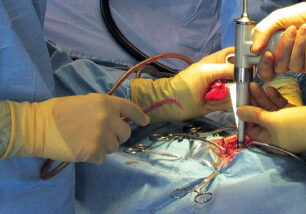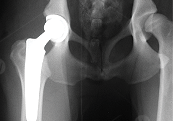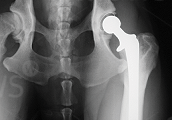Why Should I Bring my Pet to Willows for Total Hip Replacement?
Willows is one of Europe’s leading small animal Orthopaedic referral centres treating over 1000 new patients a year. Our state-of-the-art hospital is led by internationally renowned Specialists committed to providing the highest standards of care. Our team of Orthopaedic Specialists have performed hundreds of hip replacements on dogs and cats.
Our Orthopaedic Surgeons are supported by our multi-disciplinary team of Specialists across a number of disciplines including; Anaesthesia, Diagnostic Imaging and Emergency and Critical Care. Willows has a large dedicated team of Nurses and clinical support staff available 24 hours a day, every day of the year to provide the best possible care for your pet.
What is Total Hip Replacement (THR)?
Total hip replacement involves removing the hip joint (the round head of the thigh bone and its cup in the pelvis) and replacing them with a metal head and a smooth plastic or plastic and metal cup. This is an effective way of eliminating pain from a diseased hip joint whilst providing an artificial joint that functions in a very normal way.
What are the Signs that my Pet needs a Total Hip Replacement?
THR surgery is carried out in dogs and cats with persistently painful hips who are not responding satisfactorily to medical management i.e. exercise restriction, weight control and cautious use of pain killers.
Signs of hip pain include difficulty rising and jumping, stiffness, lameness, restlessness, and reluctance to exercise and play. The most common cause of hip joint pain is osteoarthritis associated with hip dysplasia. This can affect dogs as young as six months. Other indications for THR surgery include dislocation (luxation) of the hip and fractures of the hip joint. THR is primarily performed in medium, large and giant dogs, however can be also be performed in small dogs and cats.
Heading What Types of Total Hip Replacements are Available?
Cemented and cementless Total Hip Replacements are available. With the cemented system the artificial cup and ball (acetabular and femoral prostheses) are held in the pelvis and thigh bone (femur) by bone cement. With the cementless system the implants are secured in the bones by what is referred to as a ‘press-fit’ so bone can grow into the surface of the implant.
Fig 1: Joint replacements are amongst the most challenging operations performed by Veterinary Orthopaedic Surgeons.

What does Total Hip Replacement Surgery Involve?
Dogs and cats have to be evaluated to see if they are suitable for THR surgery. This is done on a separate day to the surgery; often a few weeks before. The first step is to ‘measure’ the patient for the prostheses. This requires obtaining very specific X-rays of the pelvis and thigh bone (femur) so that the appropriate size of implant can be selected.
Pets will usually be admitted the day before the surgery. He or she may be fed that morning and water should not be withheld.
The operation is performed by a team of two Orthopaedic Surgeons through a relatively small incision directly over the hip. Careful preparation of the hip socket (acetabulum) and top of the thigh bone (femoral canal) is necessary prior to placement of the relevant cemented or cementless prostheses. The two artificial components are then brought together and the stability of the hip checked. The thick capsule that surrounds the joint is carefully stitched prior to closure of the rest of the wound.

Fig 2: A cemented total hip replacement

Fig 3: A cemented total hip replacement
Are there any Reasons why a Total Hip Replacement cannot be carried out?
It is important that the dog or cat has no general infections, e.g. of the skin (pyoderma), and that the hip joint to be replaced is not infected. Any previous major surgery on the hip, e.g. repair of a dislocation or fracture, may increase the possibility of complications. In general, animals who have already had the femoral head removed (excision arthroplasty) are not suitable for hip replacement surgery, although there are occasional exceptions. There is no upper age limit for a total hip replacement.
What can I Expect if my Pet has a Total Hip Replacement?
Aftercare following THR surgery is very important, as rehabilitation may take many months. Painkillers and antibiotics are prescribed at discharge. Visits to your local veterinary surgeon are necessary within the first two weeks to check the wound and remove any sutures.
Exercise must be very restricted for the first few weeks until the joint capsule and other soft tissues heal. This is the period when dislocation of the prostheses is most likely. Exercise is mainly for toileting purposes and must be on a lead or harness to prevent strenuous or vigorous activity. At other times, confinement to a pen or a small room is necessary to avoid jumping and climbing. After a few weeks, exercise may be gradually increased in a controlled manner (on a lead). Hydrotherapy may be recommended.
The first check-up at Willows is one month after the operation. Limb and hip function are evaluated at this time. Depending on progress, advice is given regarding increasing exercise. The next check-up is three months following surgery when X-rays are obtained to evaluate the THR. The position of the prostheses and the bone surrounding the cement and prostheses are checked and compared to the X-rays obtained immediately following surgery. This enables stability of the prostheses to be assessed. Further advice is given regarding exercise.
Risks and Complications
The success rate of THR surgery in dogs and cats is high, with 90-95% of cases having excellent limb function. However, there are potential complications of which the most common is dislocation of the prostheses. This generally occurs within the first few weeks of surgery and often requires a second operation to reduce the dislocation. Less common complications include loosening of the prostheses, fracture of the femur and infection.
To save this page as a PDF, click the button and make sure “Save as PDF” is selected.
Orthopaedics
Find out more
To assist owners in understanding more about Orthopaedics we have put together a range of information sheets to talk you through the some of the more common orthopaedic conditions seen and treated by our Specialists.

